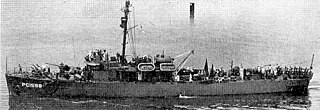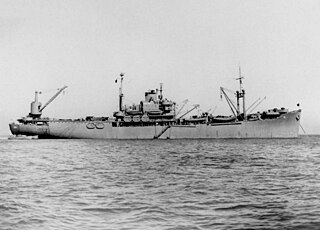
USS Curtiss (AV-4) was the first purpose-built seaplane tender constructed for the United States Navy. She was named for Glenn Curtiss, an American naval aviation pioneer that designed the Curtiss NC-4, the first aircraft to fly across the Atlantic Ocean.

USS Suisun (AVP-53) was a United States Navy Barnegat-class small seaplane tender in commission from 1944 to 1955. It was named for northern California's Suisun Bay, which takes its name from the Native American Suisun tribe.

USS Gilmore (DE-18) was an Evarts-class short-hull destroyer escort in the service of the United States Navy.

USS Excel (AM-94) was an Adroit-class minesweeper of the United States Navy. Laid down on 19 December 1941 by the Jakobson Shipyard, Inc., Oyster Bay, Long Island, New York, launched on 10 May 1942, and commissioned on 11 December 1942. The ship was reclassified as a submarine chaser, PC-1598 on 1 June 1944.

USS St. George (AV-16) was a Kenneth Whiting-class seaplane tender in the United States Navy.
The second USS Dempsey (DE-26) was an Evarts-class destroyer escort constructed for the United States Navy during World War II. She was promptly sent off into the Pacific Ocean to protect convoys and other ships from Japanese submarines and fighter aircraft. By the end of the ship's World War II service career, when she returned to the United States, she had accumulated three battle stars.

USS Manlove (DE-36) was an Evarts-class destroyer escort of the United States Navy during World War II. She was promptly sent off into the Pacific Ocean to protect convoys and other ships from Japanese submarines and fighter aircraft. She performed dangerous work in numerous battle areas, and was awarded five battle stars.

USS Dionne (DE-261) was an Evarts-class destroyer escort of the United States Navy during World War II. She was sent off into the Pacific Ocean to protect convoys and other ships from Japanese submarines and fighter aircraft. She performed escort and antisubmarine operations in dangerous battle areas and returned home with six battle stars, a high number for a ship of her type.

USS Pocomoke (AV-9) was a Pocomoke-class seaplane tender, originally built as the SS Exchequer and acquired by the U.S. Navy as the military build-up occurred in the United States just prior to World War II. She operated principally in the Pacific Theatre of the war and serviced military seaplanes. At war’s end, she returned to the United States with two battle stars.

USS Hamlin (AV-15) was a Kenneth Whiting-class seaplane tender in the United States Navy.
USS Control (AM-164) was an Admirable-class minesweeper built for the U.S. Navy during World War II. She was built to clear minefields in offshore waters, and served the Navy in the Pacific Ocean.

USS Custer (AP-85/APA-40) was a Bayfield-class attack transport in service with the United States Navy from 1943 to 1946. She was sold into commercial service in 1948 and was scrapped in 1973.

USS Knudson (APD-101), ex-DE-591, later LPR-101, was a United States Navy high-speed transport in commission from 1944 to 1946 and from 1953 to 1958.
USS Sotoyomo (ATR-43/ATA-121) was a rescue tug of the United States Navy that served during World War II and the early 1950s, and was sold to Mexico in 1963.











